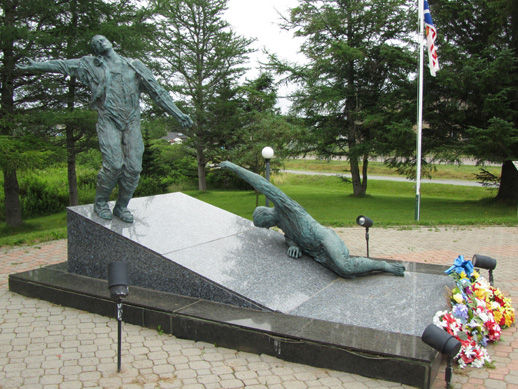
ST. LAWRENCE, Newfoundland – You may need to get out your atlas or do an online map search to really understand this story. Most of the population of the Canadian province of Newfoundland lives on the Avalon Peninsula, the easternmost hunk of Canada, and indeed of North America. Just west of Avalon is another sizable peninsula, Burin. I happened to travel there recently on my way to the ferry taking us over to the only remaining French territory in North America, the islands of Saint-Pierre et Miquelon.
My host drove a slightly longer way back up the Burin Peninsula on the return trip to her home in the provincial capital of St. John’s, in order to show me the little town of St. Lawrence, population 1349, on the exposed south coast. She knew I would appreciate what we would find there: Sad, poignant, and uplifting memories.
On the stormy night of February 18, 1942, two U.S. Navy ships, the USS Truxton and the USS Pollux, headed toward Iceland for refueling, foundered against the rocky cliffs near St. Lawrence. Over 200 seamen were lost to the sea. While sailors clung to railings and ropes against crashing waves over the listing decks, the mining folk on land scurried to the shore and hauled over lines to rescue the survivors. Almost 190 lives were saved.
Among those lives was Lanier W. Phillips, born in 1923 in Lithonia, Georgia, to a sharecropping family, in deeply infested Ku Klux Klan country. Lanier figured his only way out of a world where nary a white person had ever said a kind word to him, was to join the U.S. Navy as soon as he turned 18, in 1941. In those years, the armed forces were strictly segregated. Black servicemen were assigned to either mess detail or as personal assistants to the officers.
Black sailors had been told that they would not be able to disembark in Iceland. In subsequent interviews, Phillips stated that the half dozen or so other Black men on board had been instructed that once they reached Iceland they were not to go on land, but to stay on the ships, as the locals would not welcome them. Thinking they had crashed on Iceland’s shore, they obeyed orders and remained on the ships and they went down. Only Lanier decided to take his chances, saying that if he was going to be lynched in Iceland, he could always try to commit suicide first. Somehow, against all odds, he made it onto the Rock. Before he knew it, a white hand reached out to lift him to safety.
The men were taken into the miners’ homes, where the women worked for days cleaning spilled oil off the survivors’ bodies. How baffled they were that they just couldn’t make Phillips white again. They had never seen a Black person! But they harbored no prejudice, and for the first time in his life, Phillips felt the touch of solidarity and human kindness from a white person.
Lanier Phillips served throughout the war, and remained a Navy man. He became the first Black man to specialize in sonar. After his service, he devoted himself to civil rights, marching with Martin Luther King, Jr., and inspiring audiences with his story of the good people of St. Lawrence. He returned many times to the Newfoundland community to thank them for their valor, and became the benefactor of a children’s playground there. Years after the fact, the United States gifted the town with the U.S. Memorial Hospital in gratitude.
St. Lawrence has a small but important museum of mining. The ore mined in that area was fluor, a radioactive substance that over the course of half a century, from the 1920s to the closing of the mines in 1978, gave virtually every miner a fatal disease. One by one, they all dropped off.
A prominent monument in the town is the “Echoes of Valour” sculpture, commemorating the miners’ reaching out to the sailors in life-saving international solidarity between wartime allies.
Phillips died in 2012, a few days short of age 89, a witness to terrible history, and a survivor who found hope for humanity in the generous, altruistic acts of his fellow human beings.
The following two videos give more information about the story, and include interviews with Lanier Phillips and with local St. Lawrence residents and eyewitnesses:
https://www.youtube.com/watch?v=V_fVeYf8AWQ
https://www.youtube.com/watch?v=JJkbkBbTaYI
If you like Bill Cosby and want to hear an interview with him based on his four months stationed in Newfoundland in the 1950s, in which he expounds on the Lanier Phillips story, check out:
https://www.youtube.com/watch?v=_hmg-Mnax34
Photo: Eric Gordon/PW












Comments